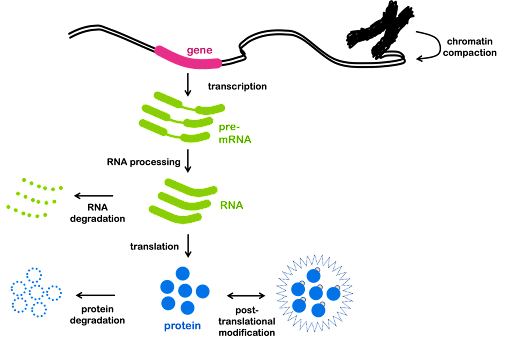Levels of gene regulation
In previous modules, we discussed the processes by which proteins are produced in a cell. Recall that protein production requires transcription of the gene, processing of the RNA, and translation of the RNA.
All these steps and others can be controlled by the cell in some fashion: are many RNAs produced from a gene, just a few, or none? Is an RNA molecule translated many times, producing many protein molecules from a single RNA? Or is it translated only a few times? Each step represents a potential control switch for the cell.
Levels of gene regulation are illustrated Figure 2:
- Chromatin compaction: How tightly the DNA is packaged affects how easily transcription machinery can access a gene.
- Transcription: Is the gene transcribed? How frequently?
- RNA processing: Is the RNA alternatively spliced? Is it edited?
- Translation: How frequently is the RNA translated?
- Post-translational modification: Does covalent addition of small molecules change protein activity?
- RNA and protein stability: How long do the RNA and protein persist in the cell before it is degraded?
Whether or not a gene is transcribed serves as the first level of gene regulation. Transcription factors can activate or repress transcription in both prokaryotes and eukaryotes. In eukaryotes, whether a gene is transcribed also depends on chromatin structure: tightly compacted chromatin cannot be transcribed because genes are not accessible to transcription machinery. This is discussed in more detail in the module on Epigenetics.

In eukaryotes, primary RNA transcripts are processed to become mature mRNA. In eukaryotes, processing serves as an additional level of regulation, since RNA splicing and/or RNA editing can result in different mRNAs produced under different cellular conditions. In both prokaryotes and eukaryotes, whether a mRNA is translated – and how many times each RNA is translated – can also be controlled. Post-translational modification of proteins can change the activity of a protein. Finally, although it is not shown in Figure 2, remember that although transcription occurs in the eukaryotic nucleus, translation occurs in the cytoplasm. Export of RNA and import and export of protein from the nucleus also can be controlled.
Transcriptional regulation of protein-encoding genes serves as the focus of this chapter, and, indeed, tends to get the most attention in genetics textbooks. However, be aware of these additional levels of regulation. If you are interested in reading more about the topic, you can read review articles about about translational regulation here, alternative splicing, and RNA transport.
Test Your Understanding
Media Attributions
- Levels of Gene Regulation © Amanda Simons is licensed under a CC BY-SA (Attribution ShareAlike) license

